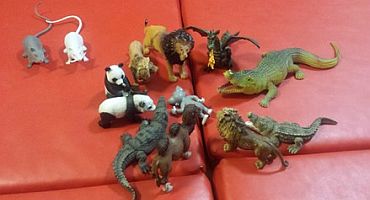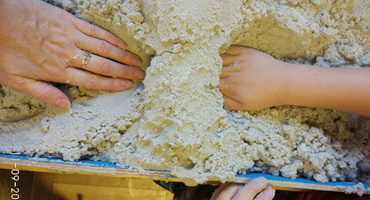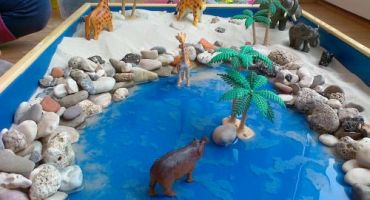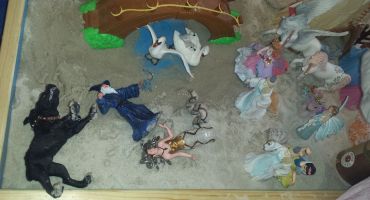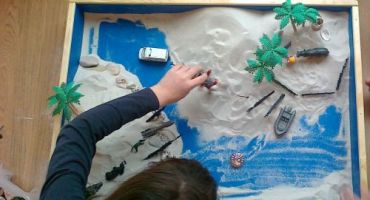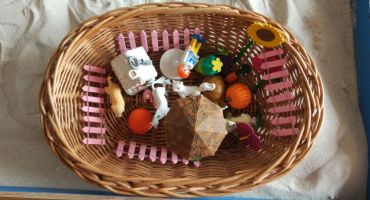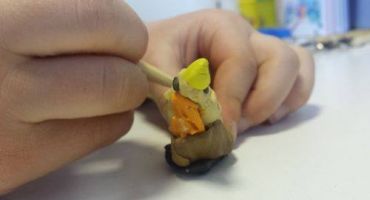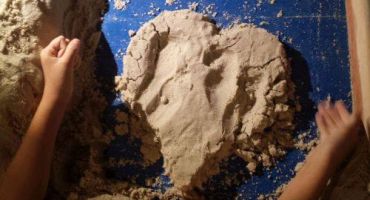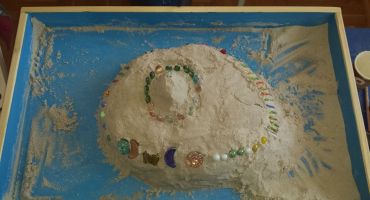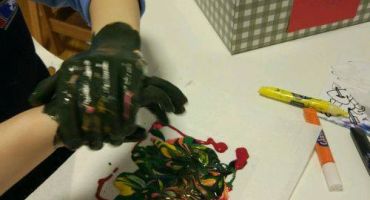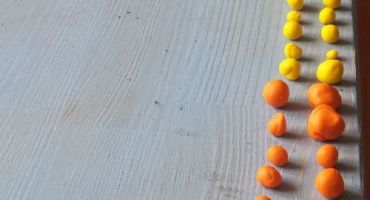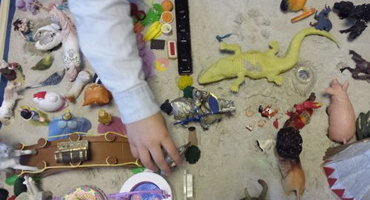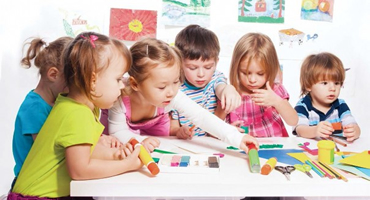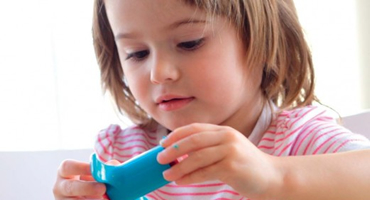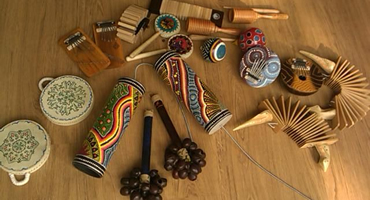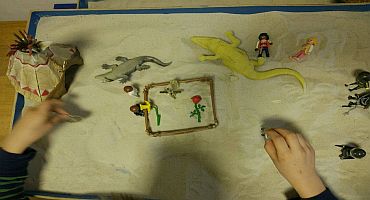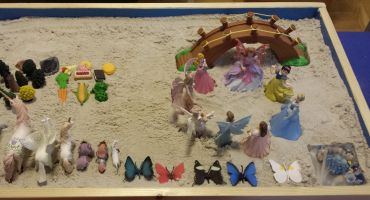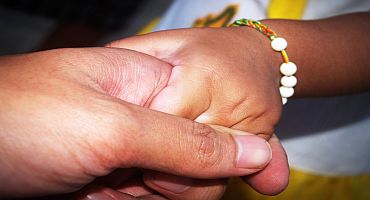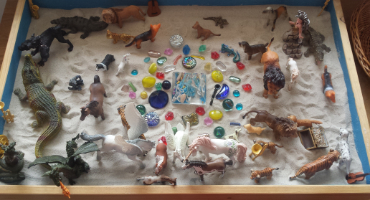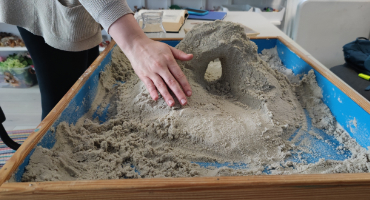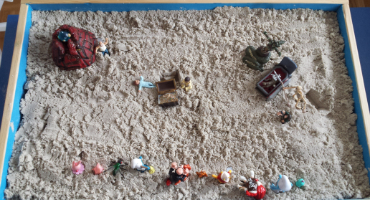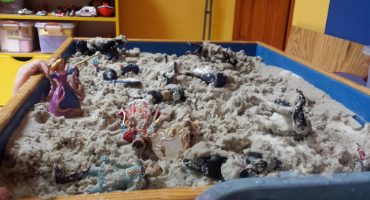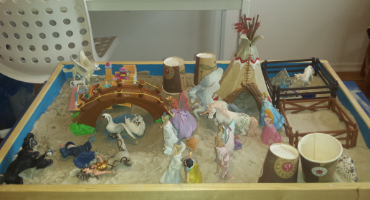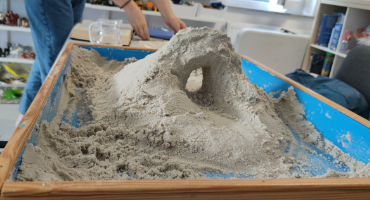Play Therapy
Nina Ambroziak in New Audiophonology 3(3), 2014
"Psychotherapy takes place where two areas of play overlap: the one that belongs to the patient and the one that belongs to the therapist". Donald Winnicott [1]
Why playing is important for the child
Play has a fundamental function in the child's physical, emotional and social development. During play, the child expresses his or her feelings, relieves stress and mental tension, improves thinking, develops the senses and satisfies the need to move. Particularly through non-directive play in contact with the therapist, the child experiences independence and the possibility to decide for himself/herself by making independent decisions and taking responsibility for these decisions. Such play stimulates the child's imagination and creativity, develops concentration, fosters self-confidence and confidence, and helps children to form friendships with others.
Playing is good for health as it promotes development; playing encourages group relationships; playing can be a form of communication in the psychotherapy process [1]
Theoretical background
Play Therapy combines different psychological approaches and psychotherapeutic schools: psychoanalytic, cognitive, interpersonal. Different psychological theories and concepts concerning the child's psychological development and the sources of pathologies in this development are used, such as.These include John Bowlby's attachment theory, object relations theories, Donald Winnicot's play theory, Margaret Mahler's separation-individuation theory, Carl Gustav Jung's concept of individuation, Erik Erickson's psychosocial theory of ego development, Jean Piaget's theory of cognitive development and Carl Rogers' client-centred approach from the humanistic movement.
Play Therapy was proposed by the American therapist Virginia Mae Axline. Her concept is an adaptation of the principles of non-directive client-centred therapy by Carl R. Rogers, who emphasised the value of striving for "self-actualisation, which is a major life force" [2, p. 62]. Axline proposed that the non-directive principle could also be applied to the process of child psychotherapy, basing it on play. In 1947, Play Therapy was first published [3] - used in various forms by therapists of all theoretical orientations. In creating Play Therapy, Axline assumed that the child had the ability to solve his psychological problems. The basis for establishing the therapist's contact with the child is the alignment of the therapist's activity with the child's current activity. The therapist emphasises and realises the child's subjectivity by following the child.
Axline's assumptions are encapsulated in eight principles of the therapist's work, which are the core principles of Play Therapy. These are:
- Creating a warm and friendly relationship with the child based on trust.
- Accepting the child as they are.
- Creating a sense of security so that the child can express themselves freely.
- The child has the right to choose and is responsible for his or her choices.
- The therapist shares and reflects the emotions expressed by the child.
- The child directs - the therapist follows.
- The therapist does not accelerate the therapeutic process.
- The therapist creates boundaries that anchor the child in reality and foster a sense of responsibility.
Working methods during Play Therapy sessions
The Play Therapy therapist integrates different types of play and creative arts techniques in his work. This distinguishes it from other therapists (e.g. therapist through drama, therapist through art, choreotherapist).
During the therapy session, called 'Special Time', the therapist uses a set of therapeutic tools called the Play Tool Kit. These include:
- Sandpit with bottom and sides in blue,
- a set of figurines for playing in the sandbox, representing human figures, domestic and wild animals, plus buildings, plants, positive and negative fairy tale characters, insects, crystals, stones, etc..,
- puppets of human figures, animals, 2 of each type,
- musical instruments 2 of each type,
- costumes and masks,
- materials for movement expression, e.g. balls, sashes, ropes, tapes, blanket,
- materials for creative activities, e.g. paints, crayons, markers, clay, pastry clay, papers and a therapeutic story and creative visualisation ? created individually for each child.
The choice of activity is always up to the child. The therapist's task during the first session is to introduce the Play Tool Kit equipment to the child so that he/she can freely choose the preferred activities. Usually during the first visit to the "Play Therapy Room", the child is positively surprised by the number and variety of means available for self-expression. This is evident in the change in behaviour, e.g. very motor-active children become calm and focused; withdrawn children become more open. Changes in the child's behaviour are noticeable at both motor and communicative levels. The therapist, acting synchronously through facial expressions, variations in the pace and intensity of movement, as well as through verbal messages, reflects to the child the emotions he or she is experiencing, creates a mirror in which the child gets to know himself or herself, "experiencing himself or herself as existing in the other person's mind" [4, p. 66]. Through this experience, the child can build a sense of his or her own existence (Figures 4 and 5).
Indications for Play Therapy
The list of indications for Play Therapy is quite broad and includes children with problems in emotional and social development. Play Therapy is recommended for children aged 3 to 12 years who present difficulties in communicating, making and maintaining friendships, with delayed speech development; sick children, disabled children. Non-directive play therapy is also recommended for children who are shy, who are constantly sad, who do not play, who withdraw from contact, who have difficulties in behaviour, in assessing their own social skills, who quarrel with peers and siblings, who have difficulties in kindergarten, in school. This form of therapy is also recommended for children who are victims of physical, emotional or sexual violence, for children who have sleep disorders or nightmares; for children who suffer from anxiety, stress, phobias, experienced trauma, have a difficult situation at home (e.g. separation, divorce of parents).
Play Therapy sessions
During the 40-45 minute therapy session, the child chooses and actively uses most of the therapeutic tools themselves. The therapist's non-directive behaviour is, for many hearing parents, the opposite of their behaviour towards their deaf child, as "the difficulty of hearing parents is the risk of being overly intrusive and directive towards the deaf child" [5, p. 51]. The child's use of varied materials, such as sand and water, paints, glue, miniature human figures, animals, trees, gives free rein and space to the child's imagination.
Creating a world, e.g. in the sand, gives the child the opportunity to experience himself in action and develops a sense of agency and control in his world. The atmosphere of unconditional acceptance so characteristic of Play Therapy and the safe relationship created between therapist and child form the basis of the therapeutic process. The safety of the child, the environment and the therapist's own safety are guaranteed through the therapist's actions, which I have written about below. The start of therapy is preceded by a meeting with the parents and the child. The purpose of this meeting is to assess the child's position in the family, to review the ways in which the family communicates and the impact of the 'sense of verbal mutilation' that results from a diagnosis of deafness in a child of hearing parents [4, p. 20]. This is followed by 1-2 meetings between the therapist and the parents. The purpose of these meetings is to interview the parents, to familiarise them with the aims of the therapy as defined by the parents, and to sign the therapy contract. In the case of therapy for a deaf child of hearing parents, the meeting with the parents provides an opportunity for the therapist to learn how the hearing mother copes with the diagnosis of deafness and, as a result, with the trauma and "the sense of loss of the child she has had so far" [4, p. 20]. The next meeting the therapist has with the child is an introductory session. During this meeting, the therapist presents the Play Room and its equipment to the child. The number of therapy sessions depends on the severity of the child's difficulties. For minor difficulties, 6 weekly meetings are suggested. For greater difficulties - 12 sessions. For severe difficulties the therapy lasts 6-12 months. The decision to end the therapy is made by the therapist and the parents once the expected goals of the therapy have been achieved.
The role of the parent in Play Therapy
The parent's task during therapy is to observe the child in everyday life, the changes in their behaviour both within the family and in the wider social environment. After every sixth session with the child, the therapist meets with the parents for what is known as a review session to discuss the changes observed, to reflect together on the reasons for the difficulties presented by the child and how to deal with them. "A high level of family involvement in the intervention is crucial for the development of language" (after Moller, 2000, in [5, p. 41]) and the creation of "a therapeutic alliance between the psychologist, the child and the child's family, which plays a huge role in the process of diagnosis and therapy" [6, s. 410]. Thus, the parent, regardless of his or her parental competence, becomes an active participant in the Play Therapy process, e.g. by sharing his or her own child's insights. In addition, during the review session with the Play Therapy therapist, the parent gains the opportunity to develop reflective function, which, according to A. Slade, is "the foundation necessary for the development of a sense of understanding of self and others, which in turn are elements of attachment" [5, p. 47]. During the meetings with the parents, the therapist also has the opportunity to experience and analyse the feelings of transference in the relationship with the parents. From this he can, among other things, make inferences about how the child feels in the relationship with the parents. From my point of view, this analysis becomes particularly important in the therapy of deaf children with hearing parents, as hearing mothers present more hostility towards deaf children than hearing mothers towards hearing children [5, p. 46].
The role of the therapist in Play Therapy
In non-directive play therapy, the role of the therapist is not passive. There is nothing more misleading than to equate non-directive play therapy (Play Therapy) with the passivity of the therapist who is merely an observer of the child's actions. The therapist's attitude is one of vigilance, of sensitivity to what the child communicates, what he does, what he says. The primary aim of the therapist's work is to mirror the child's feelings and behaviour, so that the child has the opportunity to create a sense of self. The therapist provides a 'mirror' for the child to see themselves in. Mirroring (mirroring, reflecting) can be carried out by the therapist using non-verbal communication, gestures, vocalising as well as words. By providing the child with a relaxed atmosphere with safety boundaries, the therapist allows the child to fully express himself or herself non-verbally, verbally, physically, through toys. The child is not admonished in any way by the therapist, nor is he or she burdened with guilt for the feelings and actions experienced. There is also no praise from the therapist, as the child's own evaluation is the most important thing during the session. So, for example, after painting a drawing-when children often ask "Is my drawing nice?"-the Play Therapy therapist will verbally or non-verbally reflect the child's interest in others' evaluation of the drawing. The therapist does not require the child to change anything. During the session, the child's actions are not judged as good or bad by the therapist. This attitude of the therapist is linked to a total acceptance of the child as he or she is. In this way, the relationship becomes symmetrical, without the adult being superior or wiser than the child. Often non-directive play therapy is equated with a lack of boundaries placed on the child. This is where I will disappoint many opponents of this therapy. During Play Therapy sessions, the therapist creates boundaries that keep both the child and the therapist safe. Boundaries are not placed on the child, boundaries are created when circumstances arise. For example, when a child tries to paint on a wall with markers, the therapist communicates verbally or non-verbally to the child that "the wall is not for painting, paper is for painting". When the child once again insists on wanting to paint on the wall, the therapist gives him/her a choice like "You have a choice: if you paint on the paper, your session will continue, if you paint on the wall, your session will end. The choice is yours".From my observations, I have found that in 99% of the choice situations, the children choose an acceptable form of expression, i.e. painting on a piece of paper. Thus, children make their own choices, learn to respect others' boundaries and to set their own boundaries in front of others. In Play Therapy, the age, appearance or gender of the therapist is not important. What is important is that he or she shows interest in the child and understands him or her empathetically. "Positive therapy begins with the therapist" wrote V. M. Axline [3]. He or she should be characterised by self-discipline, which makes it possible not to direct the child's actions. I know from my autopsy that an attitude of overprotectiveness in child therapists is difficult to eliminate from therapeutic work with children, especially those with disabilities. Therapists who meet all of the following criteria are eligible to conduct Play Therapy:
- They have successfully completed the training, the programme and course of which have been approved by the International Board of Examiners of Child and Play Therapy.
- They follow the ethical rules of the international organisation Play Therapy International (PTI).
- Have a current criminal record (renewed annually with PTI membership).
- They are members of Play Therapy International or its affiliates.
- They are subject to close supervision (1 hour of supervision with a PTI-certified supervisor is required per 6 hours of therapy).
- They regularly report on the results of their work and upgrade their qualifications according to the rules laid down by the PTI.
Effects of Play Therapy
Play Therapy enables a child to pay attention to and experience their own feelings in a safe, accepting environment. This helps children to learn that experiencing all feelings is acceptable and accepted, and helps children to deal with their feelings in a safe and constructive way. Through therapeutic play, guided by the principles of Play Therapy, the child is given the opportunity to resolve his/her conflicts, emotional difficulties, eliminate or change dysfunctional behaviour. During play, the child makes a "cumulative or amplified experience, which requires the presence of a trusted therapist who accepts the communication and sufficiently reflects it. Under such extremely specific conditions, the individual can integrate and exist as a whole, and this process is an expression of the sense that I AM, I am alive, I am myself" [1, p. 86].
Another effect of Play Therapy is to create in the child a representation of a secure relationship with an adult, as a result of experiencing a secure bond with the therapist. This allows the child to develop his or her social competence, transferring the new pattern of relationship with the therapist to others in his or her environment.
The use of Play Therapy in the therapy of deaf children
The child's spontaneous play in combination with the therapist's unconditional acceptance and non-directivity creates the conditions for such therapy for the hearing impaired child with delayed development of communication and speech skills, which is not based on verbal communication. As Nicole Renick Thomson [5, p. 41], among others, writes: "Effective communication is not limited to oral communication. Physical contact, eye contact and facial expression are essential for effective communication". Both eye contact and movement, gestures and facial expression are elements of the Play Therapy therapist's workshop. This use of non-verbal communication fosters a therapeutic relationship with hearing-impaired children, in whom increased sensitivity to visual stimuli can be observed as a compensation for hearing [8, p. 141]. The mirroring carried out by the Play Therapy therapist is synchronous and enables the therapist to genuinely follow the child, making the child the subject rather than the object of therapy. The therapist's high degree of involvement and sensitivity, the richness of his or her non-verbal behaviour, the flexibility of responding to the child's behaviour and, at the same time, the constancy of the boundaries in place, make it easier for the hearing impaired child to establish and maintain a safe relationship in the play interaction. These therapist behaviours are a kind of 'remedy' for the difficulties observed in the play interactions of hearing mothers with deaf children, as these mothers, compared to mothers of hearing children, were characterised by, among other things, significantly lower flexibility, sensitivity and engagement and a low amount of non-verbal behaviour [5, p. 49]. Based on my experiences so far with both the therapy of hearing and hearing children, I can say that the children love Play Therapy and each session is another adventure for them in discovering the most important person for them, i.e. themselves.
The above article by Nina Ambroziak appeared in the journal New Audiophonology 3(3), 2014
References
1 Winnicot DW. Play and reality. Gdansk: Imago; 2011.
2. Rogers C. On becoming a person. Poznan: Dom Wydawniczy Rebis; 2002.
3. Axline MV. Play Therapy. London: Churchill Livingstone; 1989.
4. Zalewska M. The child in a self-portrait with a painted face. Psychological mechanisms of identity development disorders in a deaf child and a child with delayed speech development. Warsaw: Jacek Santorski & CO Publishing House; 1998.
5. Thomson NR, Kennedy EA, Kuebli JE. Attachment formation between deaf infants and their primary caregivers: Is Being Deaf a risk factor for insecure attachment. In Zand DH,
Pierce KJ. Resilience in Deaf Children: Adaptation Through Emerging Adulthood. New York: Springer; 2011, 27?64. 6. Schier K. Countertransference as a method for diagnosing moral development in child and adolescent psychotherapy. In Grzesiuk L, Suszek H, eds. Psychotherapy. Problems of patients. Warsaw: Eneteia; 2011, 409?18.
7. Strickland B. The Gale Encyclopedia of Psychology. New York: Gale Group; 2001.
8. Sacks O. Seeing the voice. A journey into the world of silence. Poznan: Zysk i S-ka Wydawnictwo; 1998.
Do you have any questions? Contact us.
PLAY THERAPY POLAND
Piłsudskiego 4A / lok.2 (I floor)
05-077 Warszawa
